Alpha is the new beginning. With its exceptional performance and user-friendliness, the JMS-T2000GC AccuTOF™ GC-Alpha Time-of-Flight Mass Spectrometer opens up a whole new realm of possibility in mass spectrometry.
The AccuTOF™ GC-Alpha uses two new Key Technologies to provide high performance in a user-friendly way.
New High-Performance Hardware for the Discerning User
The sixth generation JEOL GC-TOFMS, the JMS-T2000GC AccuTOF™ GC-Alpha, uses an optimal ion optical system to provide ultra-high resolution and high ion transmission (= sensitivity).
Because of its newly developed, superior hardware, the AccuTOF™ GC-Alpha has six times greater resolution than the first-generation AccuTOF™ and a mass accuracy of ≤ 1 ppm. The AccuTOF™ GC-Alpha provides unrivalled data quality for qualitative GC-MS analysis.
A New Generation of Analysis Software for Simple, Speedy Operation
A new workflow has been developed to identify unknown chemicals using GC-MS. The data is analyzed by combining hard ionization (EI) and soft ionization (FI, PI, CI) data to determine the analytes present in the sample.
The AccuTOF™ GC-Alpha's msFineAnalysis software streamlines this process and allows two similar samples to be immediately compared for differential analysis. Its new, improved version of msFineAnalysis enables the operator to simply do qualitative analysis on unknown compounds as well as compounds that are not recognized in the EI mass spectral libraries.
Performance of AccuTOF™ GC-Alpha
AccuTOF™ GC-Alpha provides excellent performance for both qualitative and quantitative measurements.
Four “High” Specifications and Two “Wide” Specifications Achieved Simultaneously
The JMS-T2000GC AccuTOF™ GC-Alpha is a high-performance GC-MS system that achieves high mass resolution, precision, and sensitivity, as well as fast data acquisition, wide dynamic range, and mass range.
The high mass resolution and mass accuracy provide exceptional qualitative analytical results. The system’s high-speed data capture supports advanced GC-MS applications, including comprehensive two-dimensional gas chromatography (GC×GC). Its wide dynamic range makes it well-suited for both quantitative and qualitative analysis of complex mixtures.
The large mass range is especially suitable for direct MS measurements, and its high sensitivity provides unparalleled information regarding trace components. The different functions of the AccuTOF™ GC-Alpha make it a powerful GC-MS device that eliminates the limitations of chemical analysis.
High Sensitivity
Trace quantitative analysis can be performed using a standard EI ion source, which has ultra-high sensitivity.
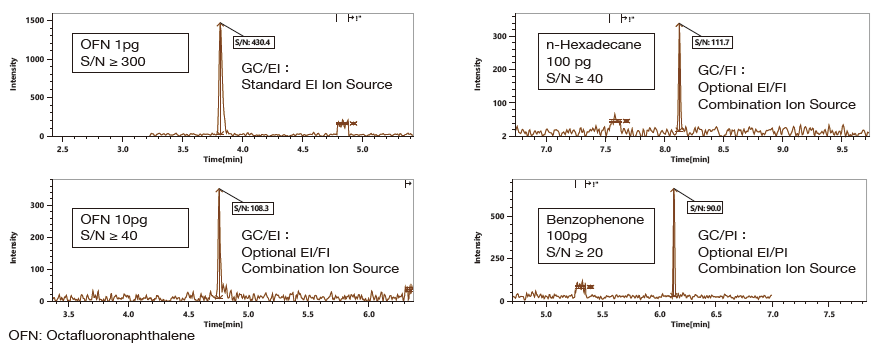
Image Credit: JEOL USA, Inc.
Instrument Detection Limit: IDL=18.7 fg
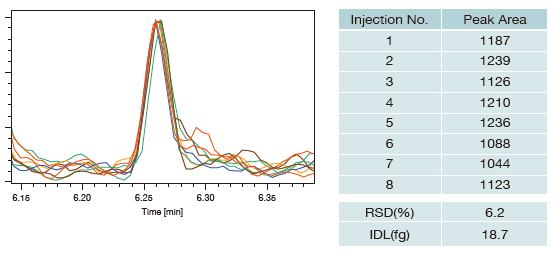
Image Credit: JEOL USA, Inc.
The standard EI source was used to perform eight consecutive measurements of octafluoronaphthalene (100 fg). The instrument detection limit (IDL) was calculated based on the peak area and reproducibility of the extracted ion chromatogram for the molecular ion. The system's IDL was calculated as 18.7 fg.
Wide Dynamic Range: 4 Orders
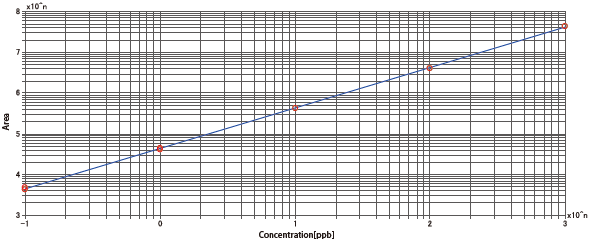
Image Credit: JEOL USA, Inc.
The standard EI source also measured octafluoronaphthalene across a concentration range of 0.1 to 1000 pg/µL, spanning four orders of magnitude. A high degree of linearity was confirmed over this range. This broad dynamic range benefits both quantitative and qualitative analysis of complex mixtures with components at varying concentrations.
High Speed Data Acquisition: 50 Hz
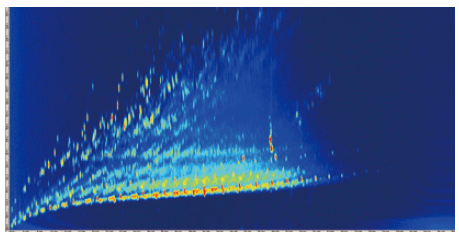
GCxGC/EI TICC of diesel fuel. Image Credit: JEOL USA, Inc.
The chromatographic peaks for GCxGC and Fast GC analyses are extremely narrow, and a mass spectrometer that can acquire data at high speeds is required. The AccuTOF™ GC-Alpha can collect data at speeds of up to 50 spectra per second, making it well-suited for sophisticated chromatographic techniques that demand fast, high-resolution detection.
Wide Mass Range: ~m/z 6000
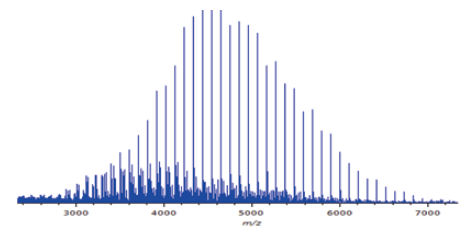
FD mass spectrum of polystyrene 5200. Image Credit: JEOL USA, Inc.
One of the advantages of time-of-flight mass spectrometers is their ability to measure a wide range of masses. The AccuTOF™ GC-Alpha can detect 6000 m/z and higher, compared to the average upper limit of an ordinary GC-MS instrument of roughly 1000 m/z. This allows for the use of direct probe MS methods, such as field desorption (FD), to measure materials like oligomers.
High Mass Resolving Power: 30,000
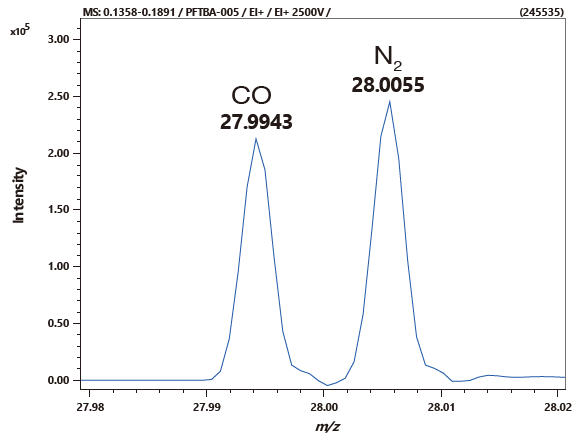
Mass separation of m/z 28. Image Credit: JEOL USA, Inc.
High mass resolving power is extremely useful for qualitative analysis: increasing the mass resolving power produces narrower mass spectral peaks, resulting in the features seen above. Increased peak centroid stability equals increased mass accuracy.
High Mass Accuracy: 1 ppm*1
The elemental compositions of the detected ions can be identified with the AccuTOF™ GC-Alpha's high mass precision. The average mass accuracy (absolute value) for ten ions detected from methyl stearate using the "drift compensation - multiple" mass calibration function was 0.05 mDa, or 0.45 ppm.
Source: JEOL USA, Inc.
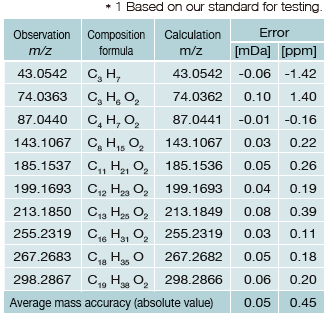
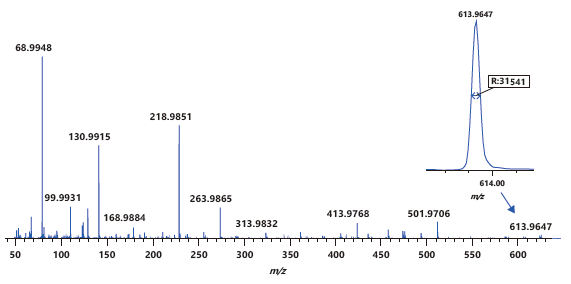
EI mass spectrum of PETBA. Image Credit: JEOL USA, Inc.
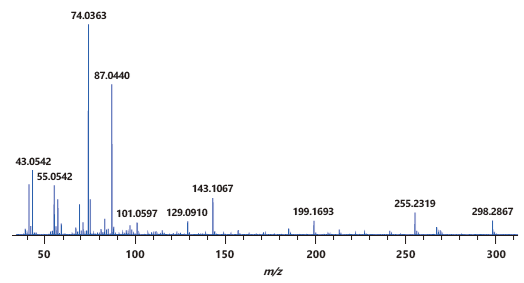
EI mass spectrum of methyl stearate. Image Credit: JEOL USA, Inc.
New Qualitative Analysis Capabilities offered by a Variety of Soft Ionizations
AccuTOF™ GC-Alpha offers a variety of ionization techniques:
Soft Ionization - A Powerful Tool for Qualitative Analysis
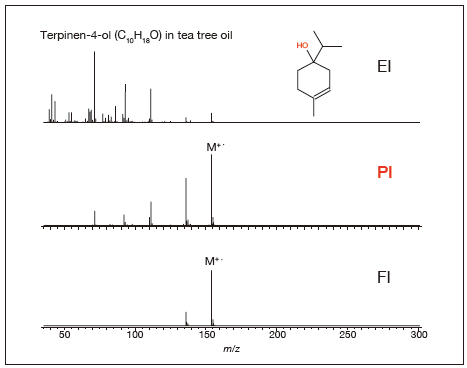
Image Credit: JEOL USA, Inc.
EI, the most used ionization method in GC-MS, has greater sensitivity and reproducibility and is backed by a large number of library searchable databases.
For scientists using GC-MS, detecting the molecular ion is essential for obtaining comprehensive structural information. EI, which uses a high energy of 70 eV, generates extensive fragmentation, enabling detailed structural analysis.
However, it can often fail to yield strong molecular ion signals. Relying solely on database searches can lead to inaccurate qualitative identification.
As a result, it is vital in GC-MS analysis to improve the accuracy of qualitative analysis by including several soft ionization techniques in addition to EI. AccuTOF™ GC-Alpha supports chemical ionization (CI), photoionization (PI), and field ionization (FI) as optional features. The analyte's elemental composition can be established confidently using the accurate mass measurement capacity of all ionization methods.
FI and FD ~ Ideal Soft Ionization Techniques for Molecular Weight Determination
FI and FD are exceptionally soft ionization procedures that give analytes lower internal energy than EI and even CI, resulting in distinct molecular ions. As a result, FI and FD are excellent for molecular weight determination.
FI (Field Ionization)
- GC or a conventional sample inlet mechanism introduces the sample into the ion source.
- Unlike CI, FI does not require a reagent gas; there is no need to select a reagent gas that is appropriate for the analyte.
FD (Field Desorption)
- The sample is applied to the emitter and introduced directly into the system.
- Appropriate for analyzing thermally labile compounds.
- Ideal for samples that are soluble in nonpolar solvents.
- Analyzes powder samples dispersible in solvents.
- Analyzes low- to mid-polar metal complexes.
- Analyzes polymers and other high molecular weight samples that GC-MS does not support.
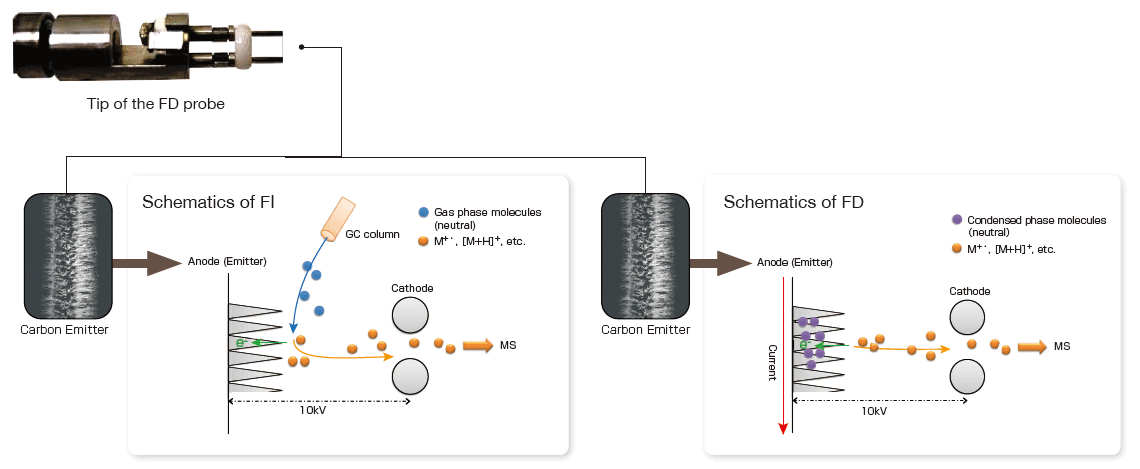
In FI and FD, ionization occurs by the removal of electrons from neutrals via the action of a high electric field. Image Credit: JEOL USA, Inc.
FI and FD ~ EI/FI/FD Combination Ion Source (Optional)
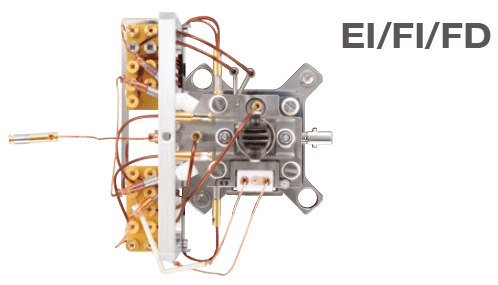
Image Credit: JEOL USA, Inc.
The AccuTOF™ GC-Alpha has a single ion source that can perform both EI (hard ionization) and FI/FD (soft ionization) procedures. Switching between EI and FI/FD is easy and rapid.
Features
- There is no need to change the ion source
- There is no reason to break the vacuum
- There is no requirement for reagent gases
Using this combination ion source with GC allows users to perform the following analyses:
- GC/EI for qualitative analysis through library search
- GC/FI for molecular weight determination
- Accurate mass measurement
PI (Photoionization) ~ EI/PI Combination Ion Source (optional)
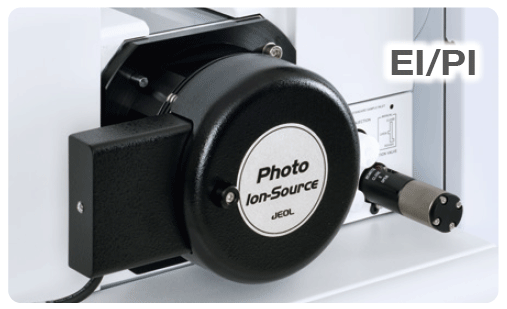
Image Credit: JEOL USA, Inc.
Photoionization (PI) is a soft ionization technique that uses photons from a vacuum ultraviolet (VUV) lamp to ionize analytes with minimal fragmentation. The AccuTOF™ GC-Alpha offers an optional combination ion source that supports both electron ionization (EI) and photoionization (PI).
Users can easily switch between EI and PI by turning the EI filament and PI lamp on or off, allowing flexible analysis within a single instrument setup.
Features
- There is no need to change the ion source
- There is no reason to break the vacuum
- There is no requirement for reagent gases
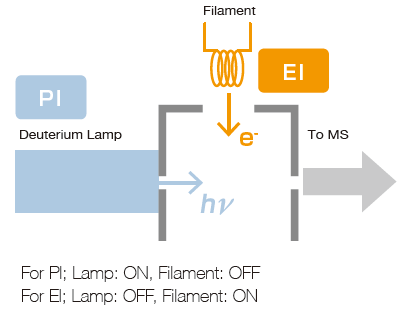
Schematics of EI/PI Combination Ion Source. Image Credit: JEOL USA, Inc.
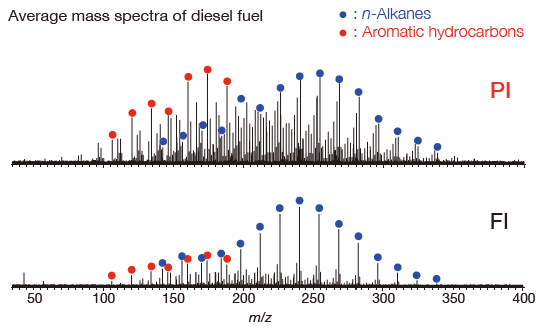
PI is particularly useful for the analysis of aromatic compounds in complex mixtures. These compounds produce high-intensity peaks with PI because they strongly absorb UV light. Image Credit: JEOL USA, Inc.
AccuTOF™ GC-Alpha with Direct MS
Direct MS is beneficial for analyzing compounds with high boiling points and mass that are not suitable for GC.
TOFMS with Inherent Wide Mass Range is Well-Matched with Direct MS Mode
It is uncommon to use GC-MS to target compounds with molecular weights greater than 1000 Da because compounds that are often analyzed by GC have molecular weights below 500 Da. However, high-boiling-point, high-molecular-weight, and nonvolatile chemicals can be targeted for measurement in direct MS mode because the sample is sent straight into the ion source.
The AccuTOF™ GC-Alpha can detect masses of up to m/z 6000. The device works well for direct MS mode measurements because it can detect chemicals over a larger mass range than traditional GC-MS.
Three Direct MS Probes to Choose From
DEP (Direct Exposure Probe)

Image Credit: JEOL USA, Inc.
- A sample dissolved or dispersed in a solvent is added to the filament at the tip
- Ideal for high-boiling-point and/or thermally labile compounds
- Compatible with EI and CI
DIP (Direct Insertion Probe)
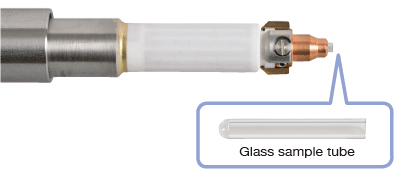
Image Credit: JEOL USA, Inc.
- A solid sample can be introduced into the glass sample tube
- Ideal for high boiling points and/or insoluble compounds
- Compatible with EI and CI
FDP (Field Desorption Probe)
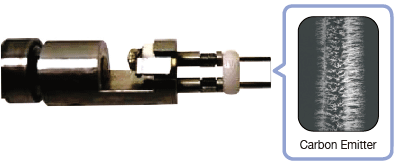
Image Credit: JEOL USA, Inc.
- The carbon emitter’s tip receives a sample dissolved or dispersed in a solvent
- Ideal for high-boiling-point, high-molecular-weight, and/or thermally labile compounds
- Ideal for metal complexes that are low to mid-polar
- Used for FD soft ionization
Polymer Analysis by FD and Kendrick Mass Defect (KMD) Analysis
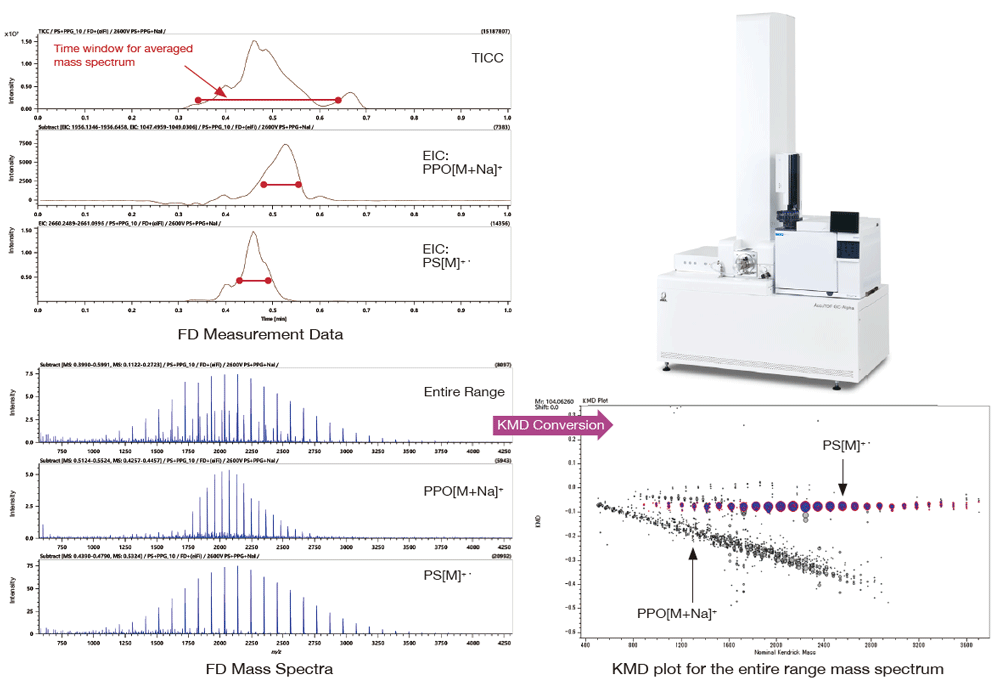
Image Credit: JEOL USA, Inc.
Field Desorption (FD) is an ionization technique that uses a strong electric field to desorb and ionize analyte molecules applied to a fine emitter surface. During measurement, the electric current through the emitter is gradually increased. This generates heat, which assists in the desorption and ionization of the analyte.
Because the optimal emitter current for ionization depends on each compound's chemical properties, different analytes may desorb at different times. This allows for partial separation of mixture components and enables mass spectral acquisition for specific compound classes.
Even when compounds are not temporally resolved during desorption, Kendrick Mass Defect (KMD) plots can differentiate and identify target components.
Key Features
High Sensitivity
- Wide Dynamic Range: 4 orders.
- High Speed Data Acquisition: 50 Hz.
- Wide Mass Range: ~m/z 6,000.
- High Mass Resolving Power: 30,000.
- High Mass Accuracy: 1 ppm (based on our standard testing).
- Instrument Detection Limit: IDL=18.7 fg.
Key Technologies
New High-Performance Hardware
The JMS-T2000GC AccuTOF™ GC-Alpha is the 6th generation JEOL GC-TOFMS, with an upgraded ion optics system for ultra-high resolution.
The AccuTOF™ GC-Alpha is an oaTOFMS with a two-stage reflector. It employs an optimum ion optical system that achieves both high ion transmission (sensitivity) and ultra-high resolution.
Mass Resolution and Mass Accuracy: Crucial for Qualitative Analysis.

The resolving power of a time-of-flight mass spectrometer is derived using the formula above. The JMS-T2000GC AccuTOF™ GC-Alpha hardware follows several concepts to obtain ultra-high resolution:
- Make t longer: Increase the flight distance 4 m
- Make Δ t smaller: New ion optical system employing a dual-stage reflectron
- Make Δ t smaller: The Ion transfer system is capable of accommodating ions with diverse kinetic energies
The AccuTOF™ GC-Alpha offers a mass accuracy of ≤ 1 ppm and six times the resolution of the original AccuTOF™ GC, thanks to the recently enhanced hardware.
For qualitative GC-MS analysis, the AccuTOF™ GC-Alpha is the best option for obtaining unparalleled high-quality data.
A New Generation of Analysis Software for Simple, Speedy Operation
A new workflow has been developed to identify unidentified compounds using GC-MS. In this approach, the data is analyzed by combining the hard ionization (EI) and soft ionization (FI, PI, CI) data to identify the analytes present in the sample.
Since its launch in 2018, the msFineAnalysis software for the AccuTOF™ GC series has been highly appreciated. It is a unique software solution for the automatic qualitative analysis of unknown compounds.
This software offers a new method of qualitative analysis for the identification of unknown chemicals. It fully uses the high-quality data acquired by the AccuTOF™ GC-Alpha.
Evolution into Version 3
Version 3 of msFineAnalysis improves software functioning and introduces a new function that allows two similar samples to be directly compared for differential analysis.
This new, improved version of msFineAnalysis enables the operator to perform qualitative analysis on unknown compounds and compounds that are not recognized in the EI mass spectral libraries.
Features of msFineAnalysis
- Combines EI and SI data for automatic qualitative analysis
- Chromatographic peak deconvolution
- Group analysis for extracting compounds with common substructures
- Differential analysis for directly comparing two samples
msFineAnalysis delivers quick and effective data analysis, allowing the user to focus on research and creativity rather than data processing!